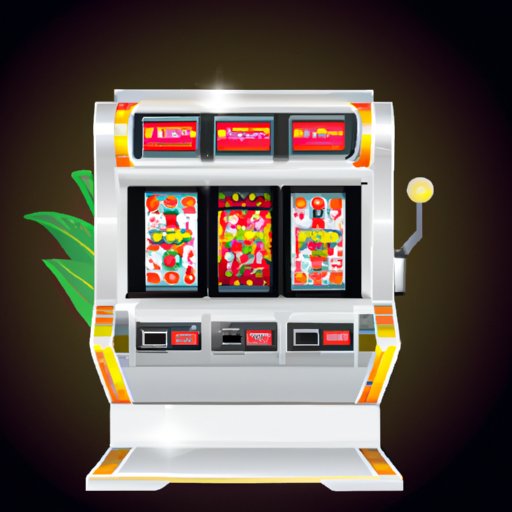I. Introduction
Slot machines are a staple in casinos worldwide, providing entertainment and the potential for big payouts. But have you ever wondered how they work? In this article, we’ll take a deep dive into the mechanics and psychology behind casino slot machines.

II. An Overview of Casino Slot Machines
At their core, slot machines operate with a computer program that generates random results. When a player pulls the lever or presses the “spin” button, the machine’s software randomly selects a set of numbers, which correspond to symbols on the machine’s reels. If the symbols match up in certain ways, the player wins a prize.
The odds of winning on a slot machine vary depending on the machine’s configuration and payout system. Machines are typically programmed to pay out a certain percentage of what they take in, known as the “payout percentage” or “return to player” (RTP). Most machines have an RTP of around 90-95%, meaning that over time, the machine will keep about 5-10% of all money wagered on it.
There are many types of slot machines found in casinos, including classic three-reel machines, video slots with multiple paylines, and progressive jackpot machines, which feature interconnected jackpots that accumulate with each play. These machines offer the potential for life-changing payouts, with some progressive jackpots reaching millions of dollars.

III. Understanding Random Number Generators
Random number generators (RNGs) are the backbone of modern slot machines. These computer programs use complex algorithms to ensure that each spin is entirely random and independent of all previous spins. This randomness ensures fairness, as no player can predict or influence the outcome of a spin.
When a player presses the “spin” button, the RNG generates a set of numbers, each of which corresponds to a symbol on the reels. The machine then displays the symbols that correspond to those numbers, creating a randomized combination of symbols that can either result in a win or a loss.
To ensure that RNGs are not tampered with, casinos subject their machines to regular testing and certification by third-party auditing firms. These firms rigorously test the machines to ensure that they are random and fair, and any casinos found to be using tampered machines can face significant fines and penalties.

IV. The Role of Psychology in Slot Machine Design
Slot machines are not only designed for random gameplay but also to keep players engaged and coming back for more. Casinos use a variety of psychological tricks and tactics to hook players and keep them playing for longer periods.
One of the most influential factors in slot machine design is sound. The sound of spinning reels and the beep of a winning combination creates a Pavlovian response in players, who hear the sounds and associate them with the possibility of a big win. Similarly, the use of bright graphics and flashing lights creates a sense of excitement and urgency, making players feel invested in the outcome of each spin.
Understanding the psychology behind slot machine design can be crucial for players looking to break away from addictive behaviors. By recognizing how casinos use psychological tricks to keep players engaged, individuals can take steps to limit their play and avoid falling into compulsive behavior patterns.
V. Slot Machine Strategies for Winning
While there is no guaranteed way to win on a slot machine, some strategies can increase a player’s odds of winning or maximize their potential payouts. For example, playing machines with a higher RTP increases the probability of payouts over time. Similarly, playing machines with a lower minimum bet can allow players to make their money last longer.
However, it’s essential to recognize that slot machine strategies are not foolproof and can sometimes lead to greater losses. Playing conservatively, setting and sticking to spending limits, and viewing slot machines as entertainment are all critical to responsible gambling and avoiding addictive behavior.
VI. The Evolution of Slot Machines
Slot machines have come a long way since their inception in the late 19th century. The first machines were mechanical devices that used rotating wheels to generate results. Today’s machines, by contrast, are entirely computerized, with RNGs and complex software programs that offer a vast array of features and gameplay styles.
Some of the latest trends in slot machine technology include skill-based games, which allow players to use their expertise to influence the outcome of a spin, and virtual and augmented reality games, which provide immersive gaming experiences akin to video games and other interactive entertainment.
VII. Learning the Lingo of Slot Machines
As with any game, slot machines have their own set of unique terminologies and phrases. Understanding these terms can help players make more informed choices about how and where to play.
- Payline: The combination of symbols that results in a payout
- Scatter: A special symbol that can trigger bonus rounds or result in payouts, regardless of where it appears on the reels
- Wild: A special symbol that can substitute for any other symbol on the reels, increasing a player’s chances of hitting a winning combination
- Bonus rounds: Special rounds of gameplay triggered by landing specific symbols or combinations of symbols
VIII. Conclusion
Understanding the inner workings of slot machines can help players approach the game with a greater sense of knowledge and responsibility. While slot machines offer the potential for big payouts and exciting gameplay, they can also be addictive and lead to financial difficulties.
By playing conservatively, setting spending limits, and recognizing the psychological tricks used by casinos to keep players engaged, individuals can enjoy slot machines as a form of entertainment without falling into compulsive behaviors.
